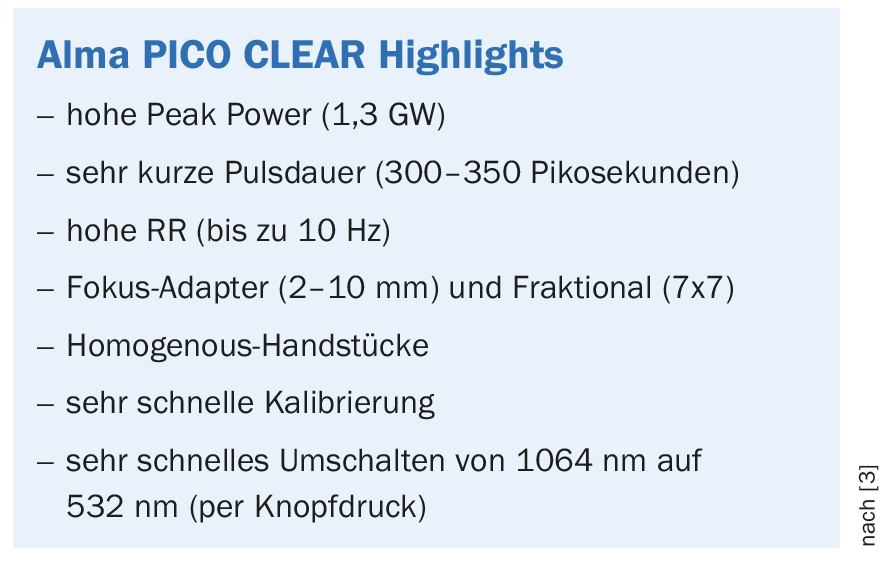Previous laser treatments of tattoos were often insufficient. Picosecond lasers produce better results than nanosecond lasers, and the efficacy is also very good for pigment lesions.
The development of lasers with a pulse duration in the picosecond range is a milestone in laser technology. Combining high efficacy with a low rate of side effects, picosecond lasers have great future potential, concludes a review published in 2019 [1]. In particular, it represents a major advance in the areas of tattoo removal and treatment of benign pigmentary lesions, and its use in other indications is currently being explored.
Alma PICO CLEAR is one of the market leaders
With a pulse duration of 300-350 picoseconds (ps), Alma PICO CLEAR has the shortest pulse duration on the market. In addition to removal of pigmented lesions and dark colored tattoos, this laser device can also be used for skin rejuvenation and other indications. It is well known that a shorter pulse duration leads to better effects due to a higher explosive force on the pigments. The speaker demonstrated this impressively with a concrete comparison of the results between the ruby laser SINON II (pulse duration 20 ns) and the Alma PICO CLEAR (pulse duration 300-350 ps) [2].
Efforts are underway to make this cutting-edge, high-performance device available to the local market, as Dr. Uwe Schmidt, head of clinical trials and training at Alma Lasers GmbH, announced during the luncheon lecture at the SGML annual meeting. His company regularly organizes workshops at which the new laser devices are presented (e.g. at the Smartaging Swiss Academy) [3].
Quantum leap for the field of tattoo removal
The treatment of tattoos with nanosecond lasers often leads to unsatisfactory results. Scarring and other negative long-term consequences are not uncommon. Picosecond lasers, on the other hand, enable precise and safe tattoo removal [4]. The speaker demonstrated this with a case study. The ruby laser resulted in blistering and scarring despite the use of low energy, which was not the case with the picosecond laser.

There is an increasing demand for tattoo removal. In the 1990s, tattoos were trendy as an expression of a facet of identity or simply as body art, especially among young people. As they age, most people want to part with these relics of past phases of their lives. About half of all tattooed people later wish to have a tattoo removed. In addition to the subjective change in perception, unpleasant physical side effects or stigmatization can also be a motivating factor. A failed tattoo removal that aggravates rather than alleviates the disfigurement problem is very distressing for those affected. The use of picosecond lasers ensures more effective treatment with fewer side effects than previous lasers.
Source: SGML Lasers&Procedures, January 17, 2019, Zurich
Literature:
- Torbeck RL, et al: Evolution of the Picosecond Laser: A Review of Literature. Dermatol Surg 2019; 45(2): 183-194.
- Slide presentation Dr. Uwe Schidt, ALMA LASERS GmbH, SGML Lasers&Procedures, 17.01.2019, Zurich.
- Smartaging Swiss Academy, https://smartaging-swiss.academy/de/kurse/firmenevent/95-almalasers-exklusiv-wokshop-picosekundenlaser).
- Ibrahim O, et al: Picosecond Lasers. Do the data support the claims? Advances in Cosmetic Surgery 2018; 1: 175-183.
DERMATOLOGIE PRAXIS 2019; 29(1): 31











